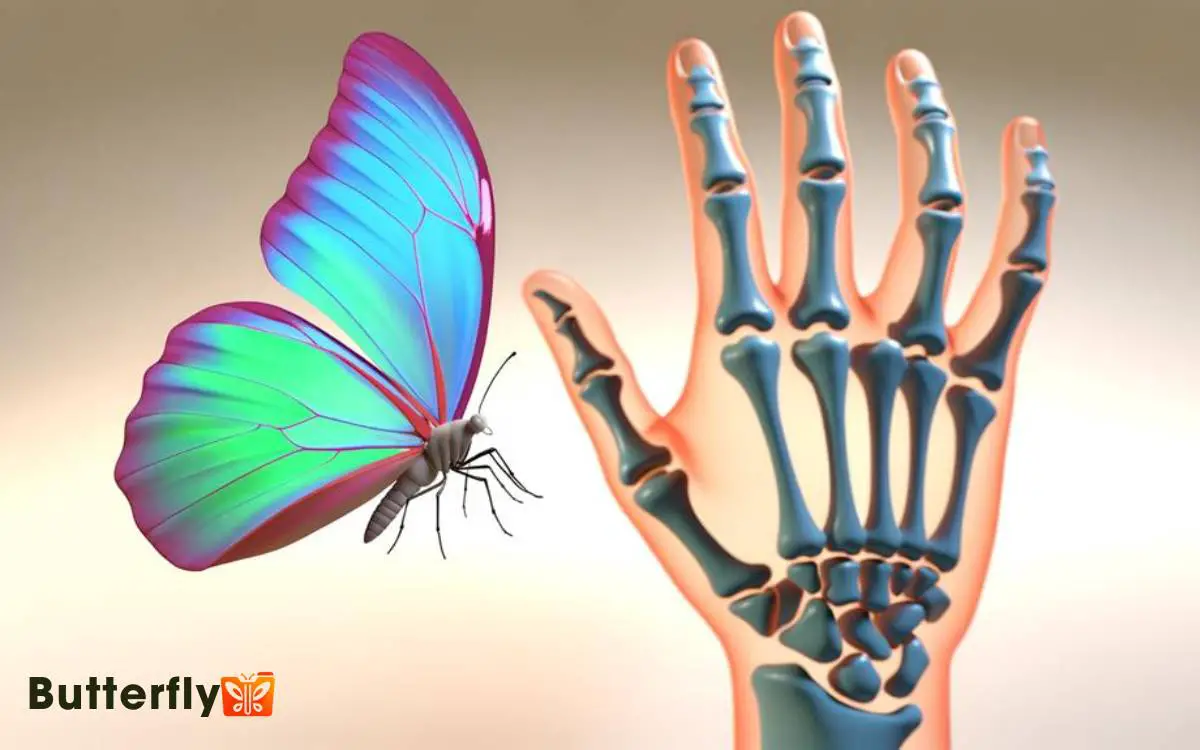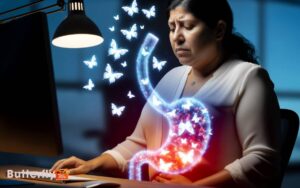Does a Butterfly Have Bones? No!
Additionally, butterflies have an open circulatory system and breathe through a network of tracheae. Their sensory organs and feeding mechanisms are highly adapted for survival. There’s a lot to learn about their intricate anatomy and life cycle.

Key Takeaways
Butterfly Anatomy Overview
A butterfly’s anatomy is a marvel of evolutionary design, comprising distinct segments that include the head, thorax, and abdomen, each specialized for different functions.
You’ll find the head housing sensory organs like antennae and compound eyes, important for navigation and locating food.
- The thorax, a muscular powerhouse, supports the wings and legs, enabling flight and mobility.
- Lastly, the abdomen contains essential systems for digestion, reproduction, and excretion.
Each segment is intricately designed to maximize the butterfly’s efficiency and adaptability in its environment. Understanding this segmented structure is necessary to grasp how butterflies thrive and interact with their surroundings.
The sophisticated organization of these body parts highlights the complexity and precision inherent in their biological makeup.
Exoskeleton Explained
You’ll find that a butterfly’s exoskeleton, composed primarily of chitin, serves multiple critical functions. This rigid outer structure not only protects internal organs but also aids in preventing desiccation.
As the butterfly grows, it undergoes molting, shedding its exoskeleton to accommodate its increasing size.
Structure and Composition
Ever wondered how butterflies maintain their delicate yet resilient form without bones? It’s all thanks to their exoskeleton, a rigid external structure made primarily of chitin. This natural polymer provides both strength and flexibility.
You’ll find the exoskeleton composed of three distinct layers: the epicuticle, exocuticle, and endocuticle. The epicuticle is the outermost layer, offering waterproofing and protection.
Beneath it, the exocuticle adds rigidity and is rich in chitin. The innermost layer, the endocuticle, is more elastic, allowing for movement.
Together, these layers create a lightweight yet sturdy framework, enabling butterflies to fly and navigate their environment despite their lack of internal bones. Understanding this structure helps you appreciate their complex biology.
Protective Functions
In addition to providing structural support, the butterfly’s exoskeleton plays a vital role in protecting the insect from environmental hazards and predators.
This exoskeleton, a rigid outer layer made of chitin and proteins, acts as a barrier against physical damage, dehydration, and microbial invasion.
By understanding its protective functions, you’ll gain insight into how butterflies survive in diverse environments.
- Physical Protection: Shields internal organs from injury.
- Water Retention: Prevents desiccation by reducing water loss.
- Microbial Defense: Blocks pathogens and parasites.
- Camouflage and Warning: Enhances survival through coloration and patterns.
The exoskeleton’s multifaceted role ensures butterflies maintain homeostasis and avoid predation, making it essential for their survival.
Growth and Molting
Understanding how butterflies grow and molt involves examining the intricacies of their exoskeleton and its role in their development.
Unlike vertebrates, butterflies don’t have an internal skeleton; instead, they possess an exoskeleton made of chitin. This rigid structure provides both support and protection.
As a butterfly larva, or caterpillar, grows, its exoskeleton becomes too tight. To accommodate growth, the caterpillar undergoes molting, shedding its old exoskeleton and forming a new, larger one.
This process, known as ecdysis, happens multiple times before metamorphosis into a butterfly. Each molt is hormonally regulated and vital for the larvae to reach the next stage.
Understanding these phases highlights the adaptability and complexity of butterfly development.
Role of Chitin
You might wonder what gives a butterfly’s exoskeleton its strength and durability.
Chitin, a long-chain polymer of N-acetylglucosamine, forms an essential part of the exoskeleton, providing structural integrity.
This substance not only protects the butterfly from physical damage but also prevents water loss, ensuring its survival in various environments.
Chitin Structure Explanation
Composed of long chains of N-acetylglucosamine, chitin forms a robust and flexible exoskeleton that provides structural support and protection for butterflies, replacing the need for bones.
This biopolymer is remarkably adaptable, enabling butterflies to maintain shape and mobility while being lightweight.
Chitin’s molecular arrangement allows it to serve multiple functions:
- Structural Integrity: Supports the butterfly’s body without the weight of bones.
- Flexibility: Allows for the intricate movements needed for flight and other activities.
- Durability: Resists wear and tear from environmental factors.
- Growth Adaptability: Facilitates molting, enabling butterflies to grow and metamorphose.
Chitin’s Protective Function
In addition to providing structural support, chitin’s protective function shields butterflies from physical damage and microbial threats. It forms a tough, flexible exoskeleton, acting as a barrier against predators and environmental hazards.
Chitin’s molecular structure, consisting of long chains of N-acetylglucosamine, offers resistance to abrasions and impacts. Additionally, its composition prevents water loss, maintaining hydration critical for survival.
Chitin also impedes microbial invasion. Its presence in the exoskeleton creates a hostile environment for bacteria and fungi, which struggle to penetrate the tough barrier.
Additionally, chitin can be combined with proteins, forming a composite material that’s both strong and lightweight, enhancing the butterfly’s mobility.
Therefore, chitin’s protective role is multifaceted, ensuring the butterfly’s resilience and longevity.
Wings and Scales
While butterflies lack bones, their wings are complex structures intricately covered in tiny scales that play an essential role in flight and thermoregulation. These scales not only provide coloration but also contribute to the aerodynamics of flight.
You’ll find that each scale is connected to the wing’s membrane, creating a mosaic that aids in:
- Thermoregulation: Regulating body temperature by absorbing or reflecting sunlight.
- Camouflage: Blending into surroundings to evade predators.
- Mating Signals: Displaying vibrant colors to attract potential mates.
- Structural Support: Enhancing wing rigidity and reducing wear.
Muscle Structure
Understanding the intricacies of butterfly wings naturally leads us to explore the muscle structure that powers their flight. Butterflies rely on two primary muscle groups: the direct and indirect flight muscles.
Direct flight muscles attach directly to the wings, facilitating fine-tuned movements. Indirect flight muscles, more powerful and efficient, attach to the thorax. When these muscles contract, they deform the thorax, causing the wings to move.
This dual system allows for precise control and rapid wing beats, essential for evasive maneuvers and sustained flight.
Additionally, the muscles are composed of specialized fibers that provide the necessary strength and endurance. By comprehending these structures, you’ll gain a deeper appreciation for the elegance and efficiency of butterfly flight.
Nervous System
Delving into the butterfly’s nervous system reveals a highly organized network that coordinates their complex behaviors and intricate muscle movements.
The main components of this system include the brain, a series of ganglia, and numerous nerves that extend throughout the body.
Butterflies rely on this sophisticated system for essential functions such as sensory processing. Antennae and compound eyes gather environmental information.
Motor control is another critical function, with nerves transmitting signals to muscles, facilitating flight and other movements.
Behavioral coordination is also key, as the brain integrates sensory input to produce appropriate behavioral responses.
Reflex actions are managed by ganglia without brain intervention, ensuring rapid response to stimuli.
Understanding these elements helps you appreciate the intricate biological mechanisms that enable butterflies to navigate and interact with their environment efficiently.
Circulatory System
You’ll find that butterflies have an open circulatory system, meaning their hemolymph flows freely within their body cavity. This means that instead of blood vessels like those found in mammals, their hemolymph is pumped by a simple tube-like heart. One interesting butterfly heart facts is that their heart is located along their dorsal side and helps circulate nutrients and hormones rather than transporting oxygen. Since butterflies breathe through spiracles along their bodies, their circulatory system plays a different role compared to that of humans.
Unlike closed circulatory systems, hemolymph doesn’t travel through veins but instead bathes the organs directly.
This hemolymph serves multiple functions, including transporting nutrients, removing waste, and aiding in thermoregulation.
Open Circulatory System
In butterflies, the open circulatory system allows hemolymph to flow freely through their body cavity, ensuring that nutrients and waste products are efficiently transported. This system lacks the network of veins and arteries found in closed circulatory systems.
Instead, the hemolymph bathes the internal organs directly, delivering oxygen and removing metabolic wastes.
Key features include:
- Hemocoel: The primary body cavity where hemolymph circulates.
- Dorsal Vessel: Functions as the heart, pumping hemolymph throughout the body.
- Ostia: Valves in the dorsal vessel that regulate hemolymph flow.
- Accessory Pumps: Assist in circulating hemolymph to appendages.
Understanding these components helps you appreciate how butterflies maintain internal homeostasis and survive in various environments. This system is efficient for their size and metabolic needs.
Hemolymph Functions
Hemolymph, which serves multiple critical functions including nutrient transport, waste removal, and immune defense, is essential to a butterfly’s survival and overall physiology.
This fluid, analogous to blood in vertebrates, flows freely in the open circulatory system of butterflies.
Hemolymph carries oxygen to tissues, aids in thermoregulation, and transports hormones. It also plays a crucial role by isolating and neutralizing pathogens.
| Function | Description | Importance |
|---|---|---|
| Nutrient Transport | Distributes nutrients from the digestive system | Crucial for cellular metabolism and energy production |
| Waste Removal | Removes metabolic waste products | Prevents toxic accumulation in tissues |
| Immune Defense | Contains hemocytes that fight infections | Protects against pathogens and parasites |
| Oxygen Transport | Carries oxygen to cells | Supports cellular respiration and overall function |
Understanding hemolymph’s roles offers insights into butterfly physiology and adaptability.
Respiratory System
Butterflies breathe through a series of small openings called spiracles that are located along the sides of their bodies.
These spiracles connect to an intricate network of tubes known as tracheae, which transport oxygen directly to their tissues. Unlike mammals, butterflies don’t have lungs or a diaphragm.
The spiracles open and close to regulate airflow and prevent water loss. Tracheae branch into finer tubes called tracheoles, ensuring oxygen reaches every cell.
Gas exchange occurs directly at the cellular level, making it highly efficient. Movement, aided by physical activity, helps in the distribution of oxygen throughout their bodies.
Understanding this unique respiratory system highlights the evolutionary adaptations butterflies have developed to thrive without bones or complex respiratory organs.
Sensory Organs
While their respiratory system showcases remarkable adaptations, their sensory organs reveal an equally fascinating array of specialized structures designed to navigate their environment.
Butterflies rely on compound eyes for excellent visual perception, enabling them to detect movement and vibrant colors. You’ll find their antennae indispensable for sensing chemical signals, which are essential for locating mates and food sources.
Additionally, butterflies possess chemoreceptors on their feet, allowing them to taste surfaces they land on. These structures are fine-tuned for survival, providing the necessary inputs to make critical decisions in complex environments.
Feeding Mechanisms
Have you ever wondered how these delicate creatures manage to extract nutrients from their environment?
Butterflies use a specialized feeding mechanism known as a proboscis. This long, coiled tube functions like a straw, allowing them to sip nectar from flowers. Their feeding process is both fascinating and efficient.
- Proboscis Extension: The proboscis uncoils to reach deep into flowers.
- Capillary Action: Nectar is drawn up into the proboscis through capillary action.
- Sense Receptors: Taste receptors on their feet help locate suitable feeding sites.
- Enzyme Secretion: Enzymes break down sugars to facilitate digestion.
Understanding these feeding mechanisms reveals the complexity of butterfly biology and their specialized adaptations for survival.
Life Cycle Stages
As you explore the intricate feeding mechanisms of butterflies, it’s equally fascinating to understand the various stages of their life cycle, from egg to adult.
Initially, a butterfly’s life begins as a tiny egg, usually laid on a suitable host plant. After a few days, a larva, or caterpillar, emerges, focusing solely on eating and growing. This larval stage involves multiple molts as it outgrows its exoskeleton.
Following significant growth, the caterpillar progresses into the pupal stage, forming a chrysalis. Inside this protective casing, it undergoes metamorphosis, reorganizing its body structure.
Adaptations for Survival
Butterflies exhibit a myriad of adaptations for survival, including their intricate wing patterns that serve both as camouflage and warning signals to predators.
You’ll find these adaptations fascinating:
- Mimicry: Some butterflies imitate the appearance of toxic species, deterring predators.
- Chemical defenses: Many species produce or sequester toxins from their host plants, making them unpalatable.
- Behavioral strategies: Erratic flight patterns can confuse predators, increasing their chances of escape.
- Thermoregulation: Dark wing patterns enable butterflies to absorb heat, essential for their cold-blooded physiology.
These adaptations aren’t mere accidents; they’ve evolved over millions of years, finely tuned by natural selection. Understanding these mechanisms highlights the complexity and resilience of butterflies in their ecological niches.
Conclusion
You’ve now explored the fascinating world of butterfly anatomy, from their chitinous exoskeleton to their delicate wings and specialized sensory organs.
Surprisingly, butterflies don’t have bones it’s their exoskeleton that provides structure and protection.
Did you know that a Monarch butterfly can travel up to 3,000 miles during migration?
These intricate adaptations guarantee their survival and highlight the incredible complexity of these seemingly fragile creatures.
Isn’t nature’s engineering truly remarkable?






